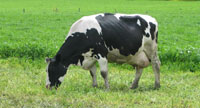Cheese from Pastured Cows: Comparing Taste, Texture and Color

The market for specialty cheese, including pastured cheese, is growing rapidly. Graziers, cheesemakers and marketers need to know how pastured cheese is unique. This report describes research comparing the taste, texture and color of cheese made from the milk of exclusively pastured cows, cows that are pastured and given a grain supplement, and cows fed a silage-based ration (TMR).
Milk from the exclusively pastured cows yielded 10-15% less cheese than the milk from the cows fed TMR and pasture plus grain. The cheese made from the milk of supplemented, pastured cows was darker, redder and yellower than the relatively whiter TMR counterpart, with the color of cheese from the pasture-only cows falling between these two treatments. The cheese made from the milk of pasture-only cows was consistently softer than the cheese from the other two treatments. A trained sensory panel found that the cheese from the two grazing treatments had a significant grassy note. The researchers were unable to identify a single compound that caused this grassy note, although they identified numerous possible compounds that could cause this odor. Consumer panelists usually gave the cheese from pastured, supplemented cows the highest scores for flavor, texture and overall liking.

